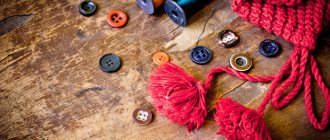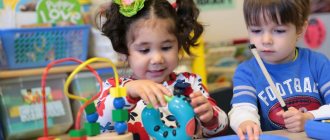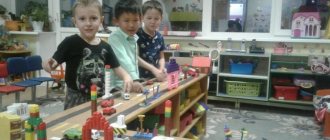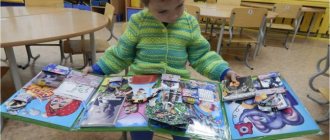Calendar and thematic planning “We are researchers” senior group.
1 half dayMorning of joyful meetings” Goal: To ensure the gradual entry of children into the rhythm of group life, to instill communication skills, love and respect for children and adults.
Morning exercises.
Ind. work according to with env. “What grows where?” Goal: consolidate knowledge about vegetables, fruits, berries.
Ind. work on FEMP “Mathematical coloring books”. Goal: to continue familiarization with geometric shapes.
Ind. work (Art), modeling “Pyramid”. Goal: to consolidate the ability to divide plasticine into pieces and create a composition.
Conversation “What is what?” Goal: to expand knowledge about wood and its properties.
Independent activity of children in activity centers.
Duty in the corner of nature, in the dining room, in classes.
Preparation for GCD
Walk.
Monitoring the operation of a bulldozer. Target :
expand your understanding of road technology.
Experimenting "Hot - Cold". Goal: To teach how to determine the temperature qualities of substances and objects.
P/i "Sparrows and cars". Goal: practice running without bumping into each other.
Ind. slave. according to Fizeau “Who will throw the snowball next?” Tasks: perform basic movements correctly, determine the winner of the competition, acting as judges and coaches with (Misha S., Misha K., Sasha Gund.)
D/ game “Echo”. Purpose: to teach to listen carefully and repeat only after a signal.
Games with external material (scapulas) Purpose: to develop the ability to play in small groups, to come up with game situations on your own.
Work before bed
:
Improve the skills of making the bed, the ability to carefully cover the bed with a blanket.
Didactic exercise “Who will make the bed correctly and quickly.”
2 half day.
The study “Music or Noise?” Goal: To teach to determine the origin of sound and distinguish between musical and noise sounds.
Playing material: Metallophone, balalaika, tube, xylophone, wooden spoons, metal plates, cubes, boxes with “sounds” (filled with buttons, peas, millet, feathers, cotton wool, paper, etc.).
Progress of the game: Children examine objects (musical and noise). The adult finds out together with the children which of them can make music. Children name objects, make one or two sounds, listening to them. An adult plays a simple melody on one of the instruments and asks what song it is. Then he finds out whether the song will work if he just knocks on the tube (no); what to call what happens (noise). Children examine boxes with “sounds”, looking into them, and determine whether the sounds will be the same and why (no, since different objects sound differently). Then they extract a sound from each box, trying to remember the noise of different boxes. One of the children is blindfolded, the rest take turns making sounds from objects. A blindfolded child must guess the name of a musical instrument or sounding object.
Theatrical activity. Magnetic theater "Morozko" Goal: To help children remember the fairy tale better, to create a desire to reproduce dialogues between fairy-tale characters (introduction to theatrical play). To develop in children the ability to listen carefully to a fairy tale; cultivate the ability to empathize with heroes and imitate; coordinate your actions when conducting a simple staging.
S/r game "Repair Shop". Goal: formation in children; interest in gaming activities, collective activities.
Drawing "Winter's Tale". Goal: learn to draw trees.
D/game “What happens in winter.” Target. Reinforce the signs of winter.
Ind. work (FEMP) “Magic wands”. Goal: to practice drawing geometric figures on the plane of the table, analyzing and examining them in a visually tangible way.
Independent play activity by design. Goal: learn to play in small groups according to independent plans.
Walk 2.
Stargazing. Goal: talk about the stars.
P/game “At the bear in the forest.” Goal: practice running without bumping into others.
D/game “Add a word.” Target :
practice selecting words that are similar in consonance.
Ind. slave. "Confusion". Goal: consolidate the names of body parts.
Ind. slave. according to Fizeau “Step wider!” Purpose: practice marching.
Ind. slave. on familiarization with the surrounding “What is what”. Goal: consolidate knowledge.
Work. Clearing paths covered with snow. Target. Learn to use a shovel correctly and finish what you start.
Ind. slave. according to Fizeau “Who will throw the snowball next?” Tasks: perform basic movements correctly, determine the winner of the competition, acting as judges and coaches with (Misha S., Misha K., Sasha Gund.)
Games with external material. Purpose: to develop the ability to play in small groups, to come up with game situations on your own
Food Analysis
Another direction for the cognitive activity of preschoolers can be the study of food products. This is relevant, because according to the new standards, special attention is paid to developing healthy eating skills in future schoolchildren and instilling in them an interest in a healthy lifestyle. To begin with, together with the teacher, the children analyze the composition of various food products, learn about what important chemicals, microelements, and vitamins must be present in the daily diet of every person. To increase the motivation of novice researchers, the teacher conducts role-playing games. Children become chefs, confectioners, doctors in order to understand how important it is to eat properly and on time. Research can be carried out not only in kindergarten, but also beyond. During walks, children offer active games to their teacher, and together they come up with comic tasks for sports competitions. The result of the work may be sports competitions, where mixed teams of children and their parents will be presented. And at the end of the holiday, you can organize a “healthy table”, which will contain only healthy products.
Ways to enhance the cognitive activity of preschool children
Modern Federal requirements for educational, educational, and developmental tasks in preschool education require special attention to the formation of initiative, independence, and cognitive activity in children.
It is the desire for independent development that is considered the main characteristic of the development of a preschooler. The baby should receive important information about the world around him, people, the laws of social life, natural objects, naturally. Cognitive and research activity in the senior group is expressed in purposefulness of thoughts and actions, concentration, desire to express one’s opinion, and compare the information received.
An example of research on bread in a preschool educational institution
Let us give an example of planning such work in kindergarten. Cognitive and research activities should be clearly thought out and distributed over months. For example, in an older group you can offer the children a topic related to bread. Such research can be called differently: “Where did the bread come from?”, “What is white gold?”, “Why does the loaf become moldy?”
Depending on the questions posed, a research plan is formed.
In September, educational and research activities begin. The older group is searching for information about the composition of bread. The teacher sets them the task of identifying the components needed to bake delicious buns and loaves. The result of this stage will be a list of ingredients without which it is impossible to bake bread.
In October, kids go with their mentor on an excursion to a bakery. They must visually become familiar with the technology of making rolls and bread, confirm the information that they collected in September about the components of bread.
In November, children receive homework. Together with their parents, they must try themselves as real bakers and master the basic stages of creating delicious white bread.
In December, educational and research activities are completed. The preparatory group is invited to a tasting of those delicious pies and buns that future first-graders made together with their mothers and fathers.
Exploring the seasons
An interesting option for research activities in kindergarten is the study of the seasons. The main goal that the teacher sets is to consolidate and deepen the knowledge that the children already possess. This type of research can be done in groups. Kids receive their own assignments, a special observation card and journals for recording their results. For example, you will need to observe for a week how brightly the sun shines, how often it rains in the fall, and write down the results in a journal. The second group will deal with temperature control, attracting parents to help. The third part will have to find out how strong the winds were during this time. After the guys complete their observations, a complete picture is drawn up. The result of such an individual-collective project will be a complete description of weather conditions in a certain season. To develop the creative imagination of children, the teacher gives them an additional task - to come up with suitable clothes for this time of year, made from non-traditional materials. The best works can be “brought into reality” by making a real fashion show at a joint celebration of parents and children.
Functions of cognitive and research activities in kindergartens
Psychologists identify several main functions of such work that are important for the child.
- Development of curiosity in preschoolers (cognitive initiative).
- A preschooler's mastery of spatial, classification, and temporal relations.
- Transition from systematization of received information to the level of practical activity.
- Formation of vocabulary, thinking, attention, analysis skills, and conversation.
Cognitive and research activities of children contribute to broadening their horizons, mastering ideas about the social and natural community, and forming simple historical and geographical knowledge.
Techniques for stimulating the self-development of preschool children
Cognitive and research activities in the senior group are stimulated by a variety of pedagogical techniques. First of all, the teacher tries, through imagery, motivation, and emotionality, to ensure that his students are interested in the task assigned to them. A wise mentor pretends that he himself does not know the answer to this question, and only the child can help him with this, and so joint cognitive and research activities begin. The average kindergarten group according to the Federal State Educational Standard also involves various types of projects and research conducted under the direct supervision of the teacher. Gradually, the teacher fades into the background, giving children the opportunity to independently obtain the results of the experiment and experience. To stimulate preschoolers as they work, the teacher asks them questions: “How do you think your experiment will end?”, “What new things have you learned at this stage of work?”
Gradually, the teacher becomes a tutor, he clarifies the algorithm of the child’s actions, helps him make diagrams and drawings. Cognitive and research activities in the senior group involve the use of creative imagination techniques. The child learns to imagine the result of his work. For example, if a preschooler is given the task of growing table salt crystals, he must imagine what they will look like. After the experiment is successfully completed, the child compares his initial idea with the real picture and draws conclusions about the similarities and differences between the images.
The experience that cognitive and research activities in the senior group allowed the child to accumulate will become his personal result, he will be able to use it when studying at school.
Types of cognitive activity of preschool children
In modern pedagogy, there are several options for such activities. The cognitive and research activity of preschool children can be manifested in actions according to the model proposed by the teacher. For this option, the mentor offers the kids diagrams and algorithms of action. Executive activity consists of the child accepting a certain task, choosing an option for his actions based on the proposed samples, and obtaining a personal result.




